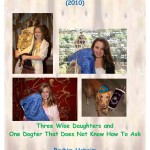Interviewee: So my family was never really Jewish. My grandfather was always like, “I’m Jew-ish.” Or maybe that’s what my aunt said about him. But he never really practiced. He only went to Temple on the high holy days, like Rosh Hashanah, and even then it wasn’t guaranteed. So we never really celebrated it in our house. But I always keenly aware of the fact that I was different from other kids. And probably that mostly stemmed from me being Hispanic.
Interviewer: It’s hard to celebrate Hispanic culture. Like there are no Hispanic mainstream holidays.
Interviewee: Yeah and like living in the whitest town in the country. I tried to make my family celebrate Hanukkah, and my mom was always open to it even though she was super Catholic. She just loves God, I don’t really get it. But it never really worked out because my Dad didn’t celebrate Hanukkah as a kid, he celebrated Christmas. So that didn’t really work out.
But then my best friend since basically birth, his Mom is Jewish and his grandmother wanted to start doing Passover with them. So they invited us over for Seder. And now it’s become this big thing where I always look forward to Passover, I looked forward to it all year.
So we would get together and the joke was that he is half-Jewish on his Mom’s side, I’m half-Jewish on my dad’s side, so together the family makes an entire Jewish family.
And the thing about this friend’s grandmother is that no one in her family really likes her, but in my family we view her as a god.
Interviewer: How many times a year do you see her?
Interviewee: I make it a point to go see her whenever she’s in town. She’s really funny; she acts just like my grandmother, but she has this thick New York Jewish accent. “JR come over here, let me get a good look at you. Do a turn for me.”
So no one really likes her in that family, but in my family she is the bomb, everyone wants to hang out with her. So we would come over for Passover, and immediately she and her daughter would start fighting. It just made for the most entertaining Seders. She would be reading all slow, and her daughter would be like, “Mom you gotta pick it up.” So she would read it faster, and then at the end, she would be like, “Oh, we didn’t really do Seder this year, did we? I guess you’re not into it; you read it so quickly.” So they would start yelling and bickering.
We had some traditions with Passover that grew. Like my friend’s dad would always have the Elijah Glass. And then there is always a fight because there is a part with four children and there was four of us, me, my brother, my friend, and his sister. And there was a part with like the simple child and the wicked child. So we always fought over who was the simple child and who got to be the wicked child. You wanted to be the wicked one.
There was always the hiding of the motzah. My friend’s grandmother would hide the motzah in the house and kids would team up together and tear through the house to see who could find it first.
His grandmother would cook a brisket. So good. Motzah ball soup. We could get real Jewish.
Interviewer: And you guys didn’t really have the opportunity to get to eat that type of food?
Interviewee: We would never have that growing up. It was always like, “Ooh it’s Passover, we get to eat Motzah Ball soup.” The Seders were always super quick and not really religious. It was just fun.
ANALYSIS:
This is clearly a story about struggling to find one’s identity, as he says above that he never felt like he fit in at his all white school because of his race. I think that by turning to Judaism he found something about his difference to celebrate. That his culture no longer ostracized him from everyone else, but rather included him into this two family Seder. It is clear that the religious aspects of the dinner were not really that important because that was never why anyone really wanted to do it in these families in the first place. It seems like it is so much more about understanding and celebrating ones identity and background. With Passover and my informant’s friends grandmother, my informant was able to experience and celebrate what it was like to be Jewish; what it was like to be different. The grandmother served as the guardian into that world for my informant’s family.

